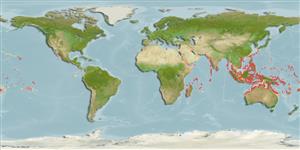Environment: milieu / climate zone / depth range / distribution range
Ecology
Marine; reef-associated; depth range 4 - 30 m (Ref. 9710). Tropical; 35°N - 28°S
Indo-Pacific: East Africa south to Natal, South Africa (Ref. 4919) and east to Samoa, northward to the Ryukyus and western sea of Japan, southward to New Caledonia and Queensland, Australia.
Size / Weight / Age
Maturity: Lm ? range ? - ? cm
Max length : 65.0 cm TL male/unsexed; (Ref. 9710)
Occur in clear lagoon and sheltered seaward reefs (Ref. 9710). Solitary (Ref. 90102). Adults usually along deep drop-offs (Ref. 48637). Usually close to shelter. Occur singly (Ref. 9710). Feed on algae, sponges, and benthic invertebrates.
Life cycle and mating behavior
Maturity | Reproduction | Spawning | Eggs | Fecundity | Larvae
Myers, R.F., 1991. Micronesian reef fishes. Second Ed. Coral Graphics, Barrigada, Guam. 298 p. (Ref. 1602)
IUCN Red List Status (Ref. 130435: Version 2024-2)
Threat to humans
Poisonous to eat (Ref. 393)
Human uses
Fisheries: minor commercial
Tools
Special reports
Download XML
Internet sources
Estimates based on models
Preferred temperature (Ref.
123201): 25.4 - 29.3, mean 28.5 °C (based on 2935 cells).
Phylogenetic diversity index (Ref.
82804): PD
50 = 0.5000 [Uniqueness, from 0.5 = low to 2.0 = high].
Bayesian length-weight: a=0.03715 (0.01590 - 0.08679), b=2.87 (2.70 - 3.04), in cm total length, based on LWR estimates for this Genus-body shape (Ref.
93245).
Trophic level (Ref.
69278): 2.8 ±0.19 se; based on food items.
Resilience (Ref.
120179): Medium, minimum population doubling time 1.4 - 4.4 years (Preliminary K or Fecundity.).
Fishing Vulnerability (Ref.
59153): Moderate to high vulnerability (46 of 100).
Nutrients (Ref.
124155): Calcium = 31.6 [13.1, 67.4] mg/100g; Iron = 0.553 [0.294, 1.236] mg/100g; Protein = 18.3 [16.0, 20.4] %; Omega3 = 0.0894 [, ] g/100g; Selenium = 39.4 [19.5, 83.5] μg/100g; VitaminA = 33.7 [8.9, 120.3] μg/100g; Zinc = 0.999 [0.678, 1.504] mg/100g (wet weight);
